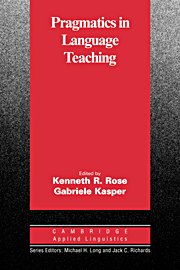Book contents
- Frontmatter
- Contents
- List of contributors
- Series editors' preface
- Preface
- Chapter 1 Pragmatics in language teaching
- I THEORETICAL AND EMPIRICAL BACKGROUND
- II ISSUES IN CLASSROOM-BASED LEARNING OF PRAGMATICS
- Chapter 4 Pragmatic and grammatical awareness: A function of the learning environment?
- Chapter 5 Why can't learners of JFL distinguish polite from impolite speech styles?
- Chapter 6 A longitudinal study of the development of expression of alignment in Japanese as a foreign language
- III THE EFFECTS OF INSTRUCTION IN PRAGMATICS
- IV THE ASSESSMENT OF PRAGMATIC ABILITY
- References
- Name index
- Subject index
Chapter 5 - Why can't learners of JFL distinguish polite from impolite speech styles?
Published online by Cambridge University Press: 05 October 2012
- Frontmatter
- Contents
- List of contributors
- Series editors' preface
- Preface
- Chapter 1 Pragmatics in language teaching
- I THEORETICAL AND EMPIRICAL BACKGROUND
- II ISSUES IN CLASSROOM-BASED LEARNING OF PRAGMATICS
- Chapter 4 Pragmatic and grammatical awareness: A function of the learning environment?
- Chapter 5 Why can't learners of JFL distinguish polite from impolite speech styles?
- Chapter 6 A longitudinal study of the development of expression of alignment in Japanese as a foreign language
- III THE EFFECTS OF INSTRUCTION IN PRAGMATICS
- IV THE ASSESSMENT OF PRAGMATIC ABILITY
- References
- Name index
- Subject index
Summary
Introduction: The indexical nature of language
Although language is a symbolic system to describe objects in the world, it is also a major tool by which we communicate who we are, what we are doing, and how we feel toward addressees and the events around us. The former is referred to as the referential function of language, and the latter its indexical function. According to Peirce (1955), there are three kinds of signs: symbols, icons, and indexes. Of these three, indexes are signs that indicate contextual information. For example, dark clouds index rain, and smoke indexes fire. Lyons (1977, p. 106) defines indexicality as “some known or assumed connexion between a sign A and its significatum C such that the occurrence of A can be held to imply the presence or existence of C.” As we can see, language is full of expressions which point to the existence of particular aspects of the social context in which they are used. For example, pronouns such as I and you index the current speaker and the current addressee, respectively, in the speech context. Spatial expressions such as here and there index a place close to the speaker and a place close to the addressee, respectively, in the speech context. Indexes are interpreted only in the current speech context. This property of linguistic expressions is called indexicality (Silverstein, 1976; Lyons, 1977; Ochs 1988; Duranti, 1997). Indexes are not limited to pronouns and spatial and temporal expressions in language.
- Type
- Chapter
- Information
- Pragmatics in Language Teaching , pp. 80 - 102Publisher: Cambridge University PressPrint publication year: 2001
- 32
- Cited by

